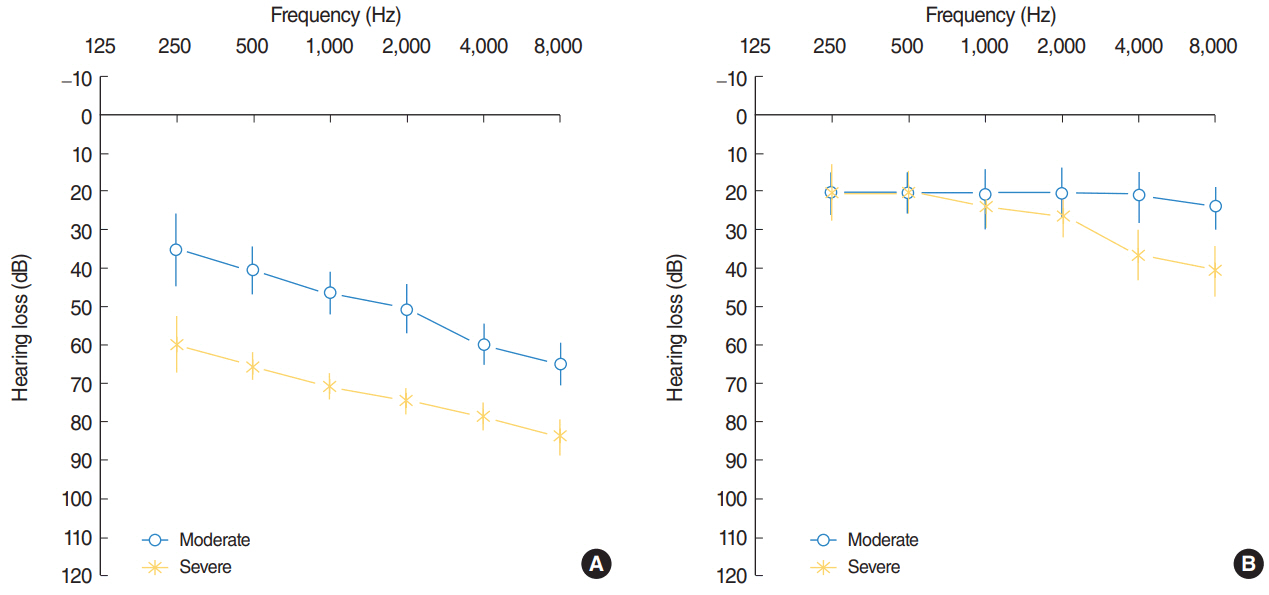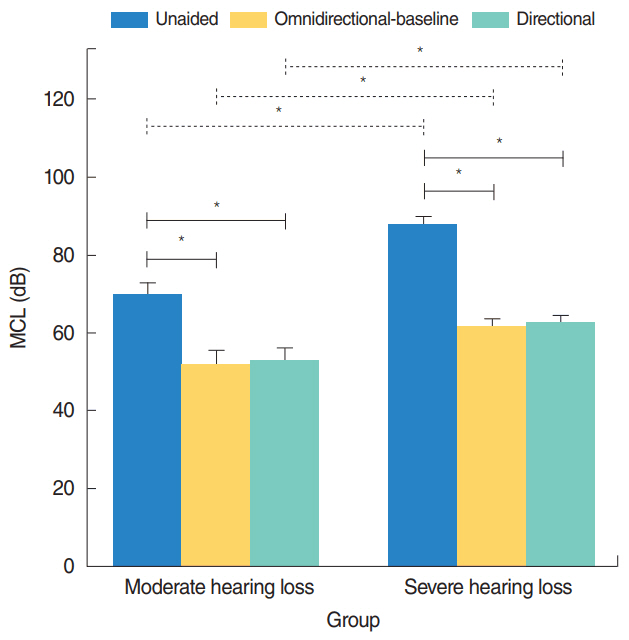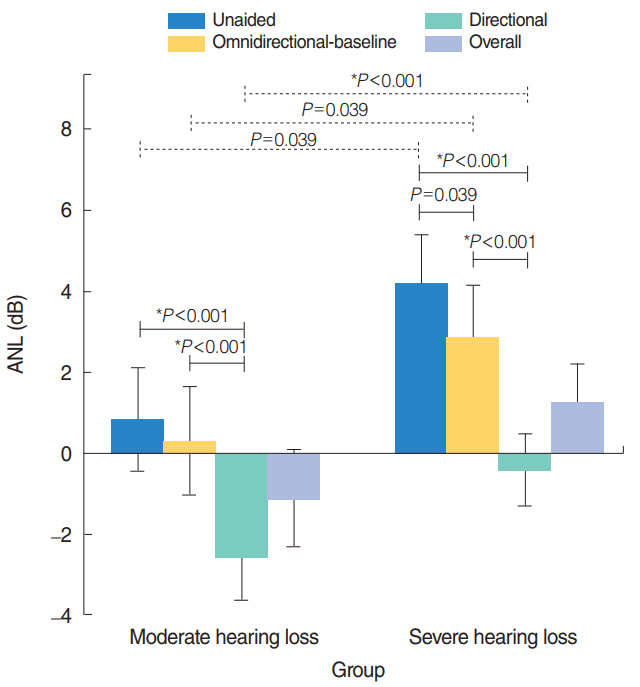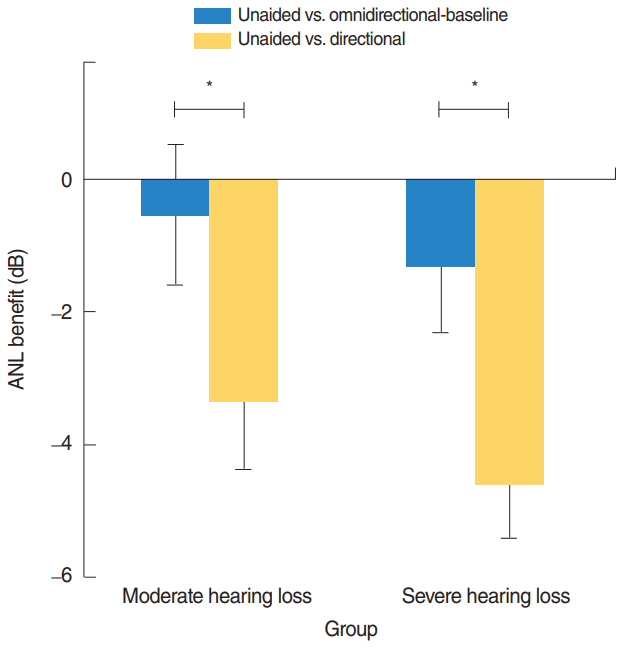Clin Exp Otorhinolaryngol.
2018 Sep;11(3):166-173. 10.21053/ceo.2017.01375.
The Acceptable Noise Level Benefit From Directionality for Listeners With Severe Hearing Loss
- Affiliations
-
- 1Department of Audiology, School of Rehabilitation, Shahid Beheshti University of Medical Sciences, Tehran, Iran. hamidjalilvand@sbmu.ac.ir
- 2Department of Basic Sciences, School of Rehabilitation, Iran University of Medical Sciences, Tehran, Iran.
- KMID: 2429005
- DOI: http://doi.org/10.21053/ceo.2017.01375
Abstract
OBJECTIVES
Directional microphone technology can enhance the speech intelligibility and listening comfort of listeners with hearing impairment. The main aim of this study is to investigate and compare the benefit derived by listeners with severe hearing loss from directional microphone technology with that derived by listeners with moderate hearing loss.
METHODS
The acceptable noise levels (ANLs) of two groups of listeners with moderate or severe hearing impairment (17 subjects in each group) were measured under unaided, omnidirectional-baseline-aided, and directional-aided conditions.
RESULTS
Although the absolute ANL of the listeners in the severe hearing loss group was significantly higher than that of the listeners in the moderate hearing loss group, their derived benefit was equivalent to that derived by the listeners in the moderate hearing loss group. ANL and hearing loss degree were significantly related. Specifically, the ANL increased with the severity of hearing loss.
CONCLUSION
Directional microphone technology can provide the benefits of listening comfort to listeners with severe hearing loss.
Figure
Cited by 2 articles
-
The Effects of Hearing Aid Digital Noise Reduction and Directionality on Acceptable Noise Level
Roghayeh Ahmadi, Hamid Jalilvand, Mohammad Ebrahim Mahdavi, Fatemeh Ahmadi, Ali Reza Akbarzade Baghban
Clin Exp Otorhinolaryngol. 2018;11(4):267-274. doi: 10.21053/ceo.2018.00052.Increased Risk of Psychopathological Abnormalities in Subjects With Unilateral Hearing Loss: A Cross-Sectional Study
Jae-Jin Song, Eu Jeong Ku, Seoyoung Kim, Euitae Kim, Young-Seok Choi, Hahn Jin Jung
Clin Exp Otorhinolaryngol. 2021;14(1):82-87. doi: 10.21053/ceo.2020.00283.
Reference
-
1. Ricketts TA, Hornsby BW. Directional hearing aid benefit in listeners with severe hearing loss. Int J Audiol. 2006; Mar. 45(3):190–7.
Article2. Leeuw AR, Dreschler WA. Advantages of directional hearing aid microphones related to room acoustics. Audiology. 1991; 30(6):330–44.
Article3. Nabelek AK, Tucker FM, Letowski TR. Toleration of background noises: relationship with patterns of hearing aid use by elderly persons. J Speech Hear Res. 1991; Jun. 34(3):679–85.4. Jalilvand H, Pourbakht A, Jalaee S. The relationship between hearing aid frequency response and acceptable noise level in patients with sensorineural hearing loss. Adv Biomed Res. 2015; Nov. 4:256.
Article5. Olsen SO, Brannstrom KJ. Does the acceptable noise level (ANL) predict hearing-aid use? Int J Audiol. 2014; Jan. 53(1):2–20.
Article6. Nabelek AK, Freyaldenhoven MC, Tampas JW, Burchfiel SB, Muenchen RA. Acceptable noise level as a predictor of hearing aid use. J Am Acad Audiol. 2006; Oct. 17(9):626–39.
Article7. Ho HC, Wu YH, Hsiao SH, Zhang X. Acceptable noise level (ANL) and real-world hearing-aid success in Taiwanese listeners. Int J Audiol. 2013; Nov. 52(11):762–70.
Article8. Walravens E, Keidser G, Hartley D, Hickson L. An Australian version of the acceptable noise level test and its predictive value for successful hearing aid use in an older population. Int J Audiol. 2014; Feb. 53 Suppl 1:S52–9.
Article9. Jonas Brannstrom K, Olsen SO. The acceptable noise level and the pure-tone audiogram. Am J Audiol. 2017; Mar. 26(1):80–7.
Article10. Recker KL, Micheyl C. Speech intelligibility as a cue for acceptable noise levels. Ear Hear. 2017; Jul-Aug. 38(4):465–74.
Article11. Kim JH, Lee JH, Lee HK. Advantages of binaural amplification to acceptable noise level of directional hearing aid users. Clin Exp Otorhinolaryngol. 2014; Jun. 7(2):94–101.
Article12. Franklin C, Johnson LV, White L, Franklin C, Smith-Olinde L. The relationship between personality type and acceptable noise levels: a pilot study. ISRN Otolaryngol. 2013; Nov. 2013:902532.
Article13. Ansari NN, Naghdi S, Hasson S, Valizadeh L, Jalaie S. Validation of a mini-mental state examination (MMSE) for the Persian population: a pilot study. Appl Neuropsychol. 2010; Jul. 17(3):190–5.
Article14. Kuk F, Keenan D. How do vents affect hearing aid performance? Hear Rev. 2006; Feb. 13(2):34–42.15. Magnusson L, Claesson A, Persson M, Tengstrand T. Speech recognition in noise using bilateral open-fit hearing aids: the limited benefit of directional microphones and noise reduction. Int J Audiol. 2013; Jan. 52(1):29–36.
Article16. Winkler A, Latzel M, Holube I. Open versus closed hearing-aid fittings: a literature review of both fitting approaches. Trends Hear. 2016; Feb. 20. https://doi.org/10.1177/2331216516631741.
Article17. Ahmadi A, Fatahi J, Keshani A, Jalilvand H, Modarresi Y, Jalaie S. Developing and evaluating the reliability of acceptable noise level test in Persian language. Sci J Rehabil Med. 2015; 4(2):109–17.18. Hornsby BW, Johnson EE, Picou E. Effects of degree and configuration of hearing loss on the contribution of high- and low-frequency speech information to bilateral speech understanding. Ear Hear. 2011; Sep-Oct. 32(5):543–55.
Article19. Keidser G, Dillon H, Flax M, Ching T, Brewer S. The NAL-NL2 prescription procedure. Audiol Res. 2011; Mar. 1(1):e24.
Article20. McRackan TR, Ahlstrom JB, Clinkscales WB, Meyer TA, Dubno JR. Clinical implications of word recognition differences in earphone and aided conditions. Otol Neurotol. 2016; Dec. 37(10):1475–81.
Article21. Christensen L, Lee L, Humes L. Can clinical word-recognition measures predict aided word recognition? Am Audit Soc Bull. 1994; 19(1):11. 16.22. Dillon H, Byrne D, Upfold L. The reliability of speech discrimination testing in relation to hearing aid candidacy. J Otolaryngol Soc Aust. 1982; 5(2):81–4.23. Olsen SO, Lantz J, Nielsen LH, Brannstrom KJ. Acceptable noise level (ANL) with Danish and non-semantic speech materials in adult hearing-aid users. Int J Audiol. 2012; Sep. 51(9):678–88.
Article24. Peeters H, Kuk F, Lau CC, Keenan D. Subjective and objective evaluation of noise management algorithms. J Am Acad Audiol. 2009; Feb. 20(2):89–98.
Article
- Full Text Links
- Actions
-
Cited
- CITED
-
- Close
- Share
- Similar articles
-
- Factors Affecting Sentence-in-Noise Recognition for Normal Hearing Listeners and Listeners with Hearing Loss
- The Effects of Hearing Aid Digital Noise Reduction and Directionality on Acceptable Noise Level
- Advantages of Binaural Amplification to Acceptable Noise Level of Directional Hearing Aid Users
- Vowel Perception in Listeners With Normal Hearing and in Listeners With Hearing Loss: A Preliminary Study
- Comparison of 50% Recognition Signal-to-Noise Ratio Using a Multi-Talker Babble Noise in Normal-Hearing and Hearing-Impaired Individuals





